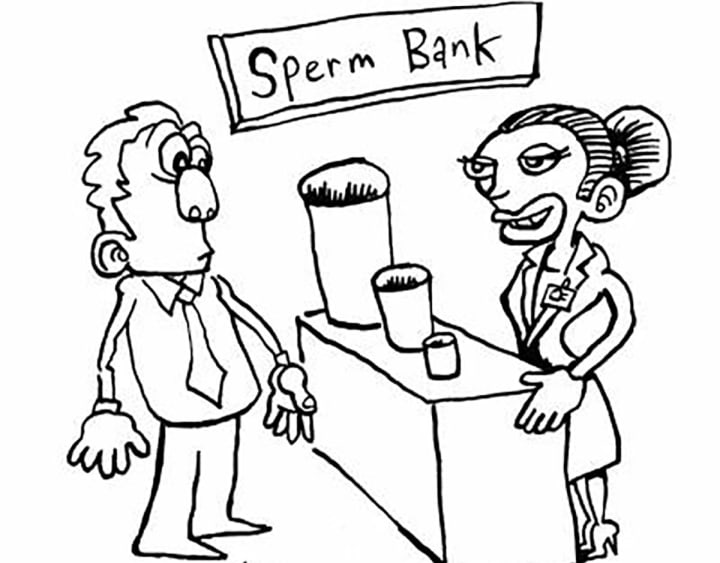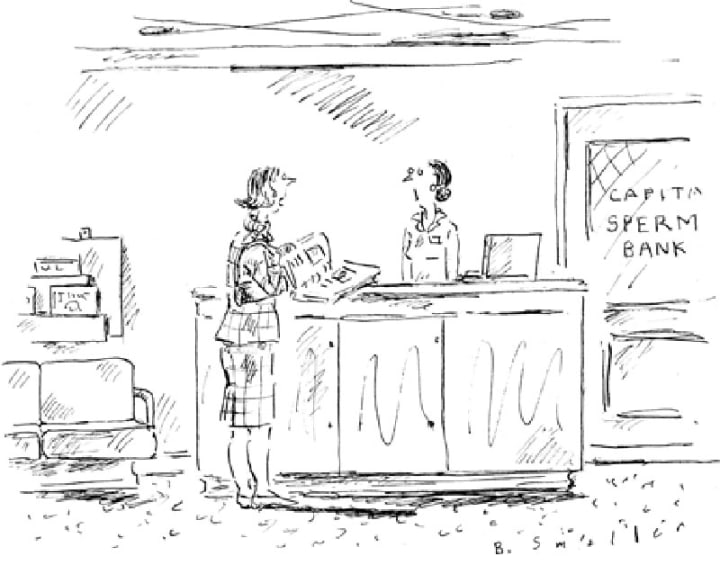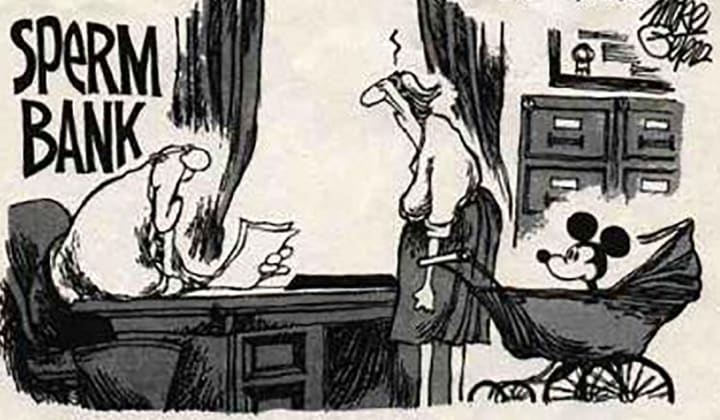History of Sperm Banks
Along with tens of thousands of other men across the country, maybe you should make a deposit in a commercial sperm bank.

A Midwestern grandfather makes a deposit at the sperm bank to assure the continuance of his family name should his son prove sterile. In the East, a 69-year-old bachelor millionaire stores semen so that should his fertility decline as he ages, he will still be able to marry and produce an heir with a presumably younger woman. And a young man is to be castrated for cancer of the testes. His surgeon advises him to store his sperm.
All these men are obtaining fertility insurance. Along with tens of thousands of others across the country, they are making deposits in commercial sperm banks.
Idant Corporation, once headquartered in a futuristically designed laboratory in midtown Manhattan, is one of the many firms exploiting the fantastic future in the biological business of storage, by freezing human semen. They still have offices in midtown, but their sperm tanks have been moved to the sperm bank of New jersey as of this article going to press.
Sperm Bank Beginnings

"How much were you thinking of spending?"
The bulk of a sperm bank's business does not come from fraternity pranks or crazy people or men unrealistically insecure about their potency; it comes mostly from men planning vasectomies. About 500,000 American men underwent the sterility surgery last year.
Vasectomy, requiring the severing of the male sperm tubes called the vas deferens, has gained great popularity as a sure-fire birth control method. Population growth continues to be a serious national and international ecological issue. The numbers will probably continue to rise for those people closer to the poverty line, while birth rates decline amongst the upper middle class.

"Good news Mr. Jones, we have lowered our standards."
American enterprise and capitalistic ideology, never allowing a profit-making vacuum to last longer than the time it takes to hit enter, spawned a new industry.
The combination of a medical and business professional at a sperm bank was the first to capitalize on the realization that since vasectomy is largely irreversible, these men might want to preserve their sperm as a kind of hedge.
Though these men have completed their families, a divorce or a death of a child or wife could create the desire for new offspring. Others may find male-ego reassurance knowing that they could still cause a pregnancy, even if only by proxy. As one genetics technician i spoke with said, "By depositing semen into the bank before a vasectomy, a man provides for a rainy day. Also, there are profound psychological implications. A man doesn't feel he's sterile knowing he has a deposit with us that could cause pregnancy. His male ego is thus intact.” Sperm banking "removes some of the psychological burden of the irreversibility of vasectomy.”
But a friend who worked for the Institute of Society, Ethics and Life Sciences in Hastings-on-Hudson, had another view of the psychological aspect. She said that sperm banking "plays on the basic anxieties of the male, and since most vasectomized depositors will never make a withdrawal, a sperm bank can supply just another way to parlay anxiety into money.”
Sperm Bank Critics

"If he is so smart, why did he have to sell his sperm?"
But there are other critics of sperm banks who attack from another, more tangible angle. They say the banks are misleading the public in their claims. There is a dispute over the length of time in which frozen sperm can remain viable. The American Public Health Association's Council on Population says that 16 months is the limit, while the sperm banks sell contracts for up to 10 years or more.
The banks argue that the low temperature at which the semen is kept, -321 degrees Fahrenheit, decreases the metabolic rate of the living sperm cell to a point where it is virtually ageless. This discovery was made in the mid 20th century and applied very successfully in cattle breeding. Generations of cattle have been bred using frozen bull semen with no detrimental side effects. Thats right, the burger you eat at McDonald's might not be as tasty without frozen sperm.
Despite reservations which many medical professionals have about sperm banking, more and more are recommending it to their vasectomy patients, to people who work in radiation environments, to professional athletes, to servicemen and to those patients undergoing radiation treatments which could cause sterilization as a side effect.
In the treatment of male infertility due to weak sperm, medically called Oligospermia, some earlier sperm banks made misleading claims. The banks claimed that by concentrating low sperm-count semen from several ejaculations, they can create an equivalent, normal-count ejaculate. Doctors argued that the processes involved, namely centrifuging and freezing, would kill most of the sperm which were probably weak to begin with.
There are also legal problems. Limited regulations exist at the federal, state or local levels which apply to the enterprises specifically. Questions of ethics, laboratory procedures and methods are left up to the labs themselves. This has caused some concern among the medical community.
"Take the case of a client who dies,” said one doctor, “leaving his wife a deposit at the sperm bank. Her husband's contract 'calls for destroying the deposit upon his death, but suppose the wife contests this. What will the courts rule? Is it her property? If she were awarded possession of his sperm, she could then use it on herself and give birth to a child of a dead man. These and other questions must be raised."
Process of Producing and Preserving the Sperm

Another hypothetical question posed concerns a laboratory possessing an “Einstein’s” semen. If the genius dies, could the semen be auctioned off to the highest bidder?
As the sperm banks grow, and prosper, laws will have to continue to catch up with the new science. The legal questions are involved and thought-provoking, as are the biological implications. With sperm banks, biological science has surely moved society a step closer to Aldous Huxley's Brave New World.
A potential client is typically informed as to the nature of sperm banking and warned that there are some imponderables about human reproduction which may prevent him from ever producing a child with frozen semen. Idant, in the "Semen Depositors Kit” given each client, includes a contract which warns that "there is a risk of having no children.” They make no guarantees. After signing the contract, the fee is paid. Fees vary.
Normally three ejaculations are stored. The client should not have an ejaculation for at least two days prior, resulting in a higher sperm count and a more potent deposit. Too long an abstinence on the other hand. leads to a watery, diluted specimen. The sperm count is the number of sperm cells in a given volume of semen. The sperm cells themselves constitute less than one per cent of the total ejaculate. The bulk consists of the products of the accessory ducts such as the seminal vesicles, the prostate and Cowper's glands. Normal semen has about one million cells in each of the 3 to 4 cubic centimeters, resulting in 3 to 4 million cells in total.
Because the sperm cells deteriorate over time, the sooner they are frozen the better. Clients are therefore encouraged to use the collection room at the labs instead of obtaining the specimen at home and bringing it in. If done at home, the clients use the small bottle in their kit. They are told to carry the specimen in an inside pocket where it is warmer. The sperm can live at or near body temperature for two hours with no damage.

"Look lady, your the one who asked for a famous movie star with dark hair, strong nose and deep set eyes."
In the ejaculation room or collection room, or as one technician referred to it, "the masturbatorium," are some materials aimed at putting the client in the right frame of mind. There are vintage magazines ranging from hard-core pornography to those of a more tame nature, such as Penthouse magazine. But if desired, a friend or a wife can be brought in to lend a hand.
After careful documentation and identification to prevent mixups, and after sperm analysis procedures to determine the state of health of the cells, special additives are used before freezing. These additives enhance the environment for the sperm and prolong their life. The freezing process itself destroys from 20 to 50 percent of the cells, which is why three ejaculates are needed.
The containers used to store the sperm resemble drinking straws, sealed at both ends. They are then placed in the liquid nitrogen tanks whose temperature is -321 degrees Fahrenheit. A normal deposit is divided into some thirty-odd sealed containers. Each one can be withdrawn separately without disturbing the rest. Each container is theoretically capable of fertilization, more than enough for most eventualities.
Sterility is a threat to all men, and the banks feel they offer security and safety to their depositors. The tanks are lead-lined, about the size of a beer barrel, and contain the semen of about a thousand men. The danger of the tanks losing their low temperature is guarded against by detection systems which monitors the temperature of the tanks. If a tank begins to defrost, an alarm goes off in the lab. If it is after work hours, the system then notifies the technicians on their phones.
The tanks depend on the uncomplicated process of evaporation and require no electricity. This makes the danger of breakdown small. Maintaining the liquid nitrogen supply is the simple safeguard against disaster. Genetics laboratories take the added precaution of storing some of the sample in another branch so not all the eggs are in one basket. Also, if they are forced out of business or go bankrupt, arrangements have been made with other medical organizations to take over the tanks until the contracts expire.
About the Creator
Frank White
New Yorker in his forties. His counsel is sought by many, offered to few. Traveled the world in search of answers, but found more questions.






Comments
There are no comments for this story
Be the first to respond and start the conversation.